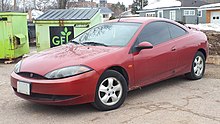Mercury Cougar
| Mercury Cougar | |
|---|---|
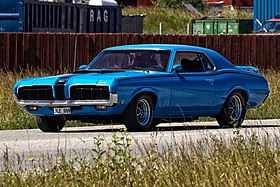 1970 Mercury Cougar XR-7 | |
| Overview | |
| Manufacturer | Mercury (Ford) |
| Model years |
|
| Body and chassis | |
| Class |
|
| Layout | Front-engine, rear-wheel drive (1967–1998) Transverse front-engine, front-wheel drive (1999–2002) |
Mercury Cougar is a nameplate applied to a diverse series of automobiles sold by the Mercury division of Ford from 1967 to 1997 and from 1999 to 2002. While the nameplate is most commonly associated with two-door coupes, at various times during its production, the Cougar was also marketed as a convertible, four-door sedan, station wagon, and hatchback.
With 2,972,784 examples produced, the Cougar is the highest-selling vehicle ever produced by the Mercury brand; its 34-year production is second only to the Grand Marquis in the Mercury model line (produced for 36 years). During the 1970s and 1980s, the Cougar was closely tied to the marketing of the Mercury division; Mercury advertised its dealers as "The Sign of the Cat" with big cats atop LINCOLN-Mercury dealer signs.[1] In line with the Cougar, several animal-related nameplates were adopted by the division, including the Bobcat, Lynx, and Sable.
During its production, the Cougar was assembled at the Dearborn Assembly Plant (part of the Ford River Rouge Complex) in Dearborn, Michigan from 1967 to 1973, San Jose Assembly (Milpitas, California) from 1968 into early 1969, Lorain Assembly (Lorain, Ohio) from 1974 to 1997, and at Flat Rock Assembly (Flat Rock, Michigan) from 1999 to 2002.
Overview[edit]
During much of its production life, the Cougar followed tradition within the Mercury division, marketed as a Mercury counterpart of a Ford vehicle. The models were distinguished by a exterior ranging in degree from grilles and lighting components to nearly the entire exterior, the Cougar shared its chassis underpinnings with Ford vehicles throughout its production life.
For its first two generations, the Cougar was derived from the Ford Mustang; initially developed as a pony car, it replaced the Cyclone muscle car in the Mercury model line.
For its third and fourth generations, the Cougar adopted the chassis of the Ford Torino intermediate. Initially the counterpart of the Ford (Gran Torino) Elite, the fourth generation was split into two model lines, replacing the Montego as the Mercury intermediate (alongside the Ford LTD II), with the Cougar XR7 becoming the counterpart of the Ford Thunderbird.
For its fifth and sixth generations, the Cougar adopted the compact Fox platform. For the fifth generation, the Cougar was again two model lines, with the Cougar XR7 derived from the Thunderbird and the standard Cougar replacing the Monarch as the counterpart of the Ford Granada. The sixth generation Cougar, derived from the Thunderbird, reverted to the two-door coupe body style.
For its seventh generation, the Cougar introduced the MN12 platform, developed for the Cougar, Thunderbird and LINCOLN Mark VIII. After 1997, the Cougar and Thunderbird were discontinued (the Mark VIII was discontinued after 1998).
For its eighth generation, the Cougar returned for 1999 as a sports compact hatchback. Sharing a chassis with the Ford Contour, the model line began development as a third generation of the Ford Probe, shifting to Mercury as its development neared completion. Sold only under the Mercury brand, this generation is the only version of the Cougar with no direct Ford counterpart (though export examples were badged as Ford Cougars).
First generation (1967–1970)[edit]
| First generation | |
|---|---|
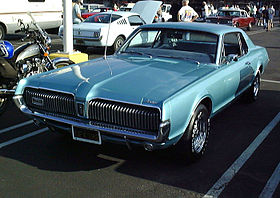 1967 Mercury Cougar | |
| Overview | |
| Model years | 1967–1970 |
| Assembly | Dearborn, Michigan, United States Edison, New Jersey, United States Milpitas, California, United States |
| Body and chassis | |
| Body style | 2-door hardtop 2-door convertible |
| Layout | FR layout |
| Related | Ford Mustang |
| Powertrain | |
| Engine | 289 cu in (4.7 L) Windsor V8 302 cu in (4.9 L) Windsor V8 351 cu in (5.8 L) Windsor V8 351 cu in (5.8 L) Cleveland V8 390 cu in (6.4 L) FE V8 428 cu in (7.0 L) FE V8 427 cu in (7.0 L) FE V8 |
| Dimensions | |
| Wheelbase | 111 in (2819 mm) |
| Length | 1967: 190.3 in (4834 mm)[2] 1969: 193.8 in (4923 mm) 1970: 196.1 in (4941 mm) |
| Width | 1967: 71.2 in (1808 mm) 1969: 75.0 in (1905 mm) 1970: 74.2 in (1885 mm) |
| Height | 1967: 51.8 in (1316 mm) 1969: 51.9 in (1318 mm) 1970: 51.3 in (1303 mm) |
The introduction of the Cougar finally gave Mercury its own "pony car". Slotted between the Ford Mustang and the Ford Thunderbird, the Cougar was the performance icon and eventually the icon for the Mercury name for several decades. The Cougar was available in two models (base and XR-7) and only came in one body style (a two-door hardtop, no center or B-pillar). Engine choices ranged from the 200 hp (149 kW) 289 cu in (4.7 L) two-barrel V8 to the 335 hp (250 kW) 390 cu in (6.4 L) four-barrel V8. A performance package called the GT was available on both the base and XR-7 Cougars. This included the 390 cu in (6.4 L) V8, as well as a performance handling package and other performance enhancements.
The 1967 Cougar, with the internal code T-7, went on sale 30 September 1966.[3] It was based on the 1967 refreshed first-generation Mustang,[4] but with a 3-in-longer (111 in) wheelbase and new sheet metal. A full-width divided grille with hidden headlamps and vertical bars defined the front fascia—it was sometimes called the electric shaver grille. At the rear, a similar treatment had the license plate surrounded on both sides with vertically slatted grillework concealing tail lights (with sequential turn signals), a styling touch taken from the Thunderbird.
A deliberate effort was made to give the car a more "European" flavor than the Mustang, at least to American buyers' eyes, drawing inspiration from the popular Jaguar E-Type. Aside from the base model and the luxurious XR-7, only one performance package was available for either model: the sporty GT. The XR-7 model brought a simulated wood-grained dashboard with a full set of black-faced competition instruments and toggle switches, an overhead console, a T-type center automatic transmission shifter (if equipped with the optional Merc-O-Matic transmission), and leather-vinyl upholstery.
This was the only generation with covered headlights. In 1967 and 1968, they were deployed using a vacuum canister system that opened and closed the headlamp doors. For 1969 and 1970, a redesigned vacuum system kept the doors down when a vacuum condition existed in the lines, provided by the engine when it was running. If a loss of vacuum occurred, the doors would retract up so that the headlights were visible if the system should fail.
The GT package included Ford's 390 cu in (6.4 L) FE-series big block, along with an upgraded suspension to handle the extra weight of the big engine and give better handling, more powerful brakes, better tires, and a low-restriction exhaust system. Introduced with the music of Herb Alpert and the Tijuana Brass' "The Work Song", the Cougar was a sales success from its introduction and helped the LINCOLN-Mercury Division's 1967 sales figures substantially. The Cougar was Motor Trend magazine's car of the year for 1967.
The Cougar continued to be a Mustang twin for seven years, and could be optioned as a muscle car. Nevertheless, the focus continued away from performance and toward luxury, evolving it into a plush pony car. The signs were becoming clear as early as 1970, when special options styled by fashion designer Pauline Trigère appeared, a houndstooth-patterned vinyl roof and matching upholstery, available together or separately. A facelift in 1971 did away with the hidden headlights and hidden wipers were adopted. Between 1969 and 1973, Cougar convertibles were offered.
The 1968 model year included federally mandated side marker lights and front outboard shoulder belts (sash belt, shoulder harness) among some minor changes. A 210 hp (157 kW) 302 cu in (4.9 L) two-barrel V8 was the base engine on all XR-7s and early standard Cougars. Three new engines were added to the option list this year: the 230 hp (172 kW) 302 cu in (4.9 L), four-barrel V8; the 335 hp (250 kW) 428 cu in (7.0 L), four-barrel V8; and the 390 hp (291 kW) 427 cu in (7.0 L), four-barrel V8. In addition, the 289 cu in (4.7 L) engine was made standard on base cars without the interior decor group midway through the model year.
Comfort and performance options available for the Cougar included the "Tilt-Away" steering wheel that swung up and out of the way when the driver's door was opened, the transmission in "park", and the ignition was off,[5] and from 1971, a power driver's seat. The new option appeared in 1968: Ford's first factory-installed electric sunroof. It was available on any hardtop Cougar, but rarely ordered on early cars.
Mercury also made limited versions of Cougar in the performance-market segment. The XR7-G, named for Mercury road racer Dan Gurney, included performance add-ons, such as a hood scoop, Lucas (brand) fog lamps, and hood pins. Engine selection was limited to the 302, 390, and 428 V8s. A total of 619 XR7-Gs were produced, and only 14 Gs were produced with the 428 CJ. The 7.0 L GT-E package was available on both the standard and XR-7 Cougars and came with the 427 V8. The 428 Cobra Jet Ram Air was available in limited numbers on the GT-E beginning 1 April 1968.[6] Conservatively rated at 335 hp (340 PS; 250 kW) at 5200 rpm and 440 lb⋅ft (597 N⋅m) of torque at 3400 rpm, the 428 Cobra Jet could produce more than the 410 hp (306 kW) from the factory. A total of 394 GT-Es were manufactured, 357 with the 427 and 37 with the 428.[7] The GT-E came with power front disc brakes as standard.[8]
- 1969–1970 Mercury Cougar
The third year of production, 1969, brought several new additions to the Cougar lineup. A convertible model was now available in either standard and XR-7 trim. The grille switched from vertical bars to horizontal bars. Tail lights still spanned the entire rear of the car and retained vertical chrome dividers, but were now concave rather than convex. Body sides now featured a prominent line that swept downward from the nose to just ahead of the rear wheels. Vent windows were removed.[9]
Performance packages were revised. The GT, XR-7G, and 7.0-L GT-E were discontinued, but the 390 and 428 V8s remained. The 302 engines were dropped, except for the "Boss" version, available only with the Eliminator package. The new standard Cougar engine was a 250-horsepower 351 Windsor. A 290 hp (216 kW) 351 Windsor V8 was also added to the engine lineup. The Eliminator performance package appeared for the first time. A 351 cu in (5.8 L) four-barrel Windsor V8 was standard, with the 390 four-barrel V8, the 428CJ, and the Boss 302 available as options. The Eliminator also featured a blacked-out grille, special side stripes, front and rear spoilers, an optional Ram Air induction system, a full gauge package including tachometer, upgraded "Decor" interior trim, special high-back bucket seats, rally wheels, raised white letter tires, and a performance-tuned suspension and handling package. It also came in vibrant colors, such as white, bright blue metallic, competition orange, and bright yellow.
Only two Cougars were produced with the Boss 429 V8 as factory drag cars for "Fast Eddie" Schartman and "Dyno" Don Nicholson. A 1969-only package was the Cougar Sports Special that included unique pin striping, "turbine" style wheel covers, and rocker panel moldings with simulated side scoops. Décor interior and performance suspension were available for the Sports Special, as were any of the optional Cougar engines, other than the Boss 302. No badges or decals denoted the Sports Special option on either the interior or exterior.
For 1970, the Cougar appearance was similar to the 1969 model, but changes were made. A new front end featured a pronounced center hood extension and electric shaver grille similar to the 1967 and 1968 Cougars. Federally mandated locking steering columns appeared inside, and high-backed bucket seats, similar to those included in the 1969 Eliminator package, became standard on all Cougars. Other changes included revised tail light bezels, new front bumper and front fender extensions, and larger, recessed side markers. The 300 hp (224 kW) 351 "Cleveland" V8 was now more available, having been featured in some 1969 XR7 models. though both the Cleveland and Windsor engines were available as the base model two-barrel engine. The 390 FE engine was now dropped, and the Boss 302 and 428CJ continued. The Eliminator received with new striping, revised colors, and the four-barrel 351 Cleveland replacing the four-barrel 351 Windsor as the standard engine. The upgraded "Décor" interior and styled steel wheels, standard '69 Eliminator equipment, were moved to the options list for the 1970 Eliminator. No Eliminator convertibles were factory produced in either 1969 or 1970. New options for the 1970 Cougar were interior upholstery and vinyl top in bold houndstooth check patterns.
Production[edit]
| Model Year | Units |
|---|---|
| 1967 | 150,893 |
| 1968 | 113,720 |
| 1969 | 100,069 |
| 1970 | 72,343 |
Second generation (1971–1973)[edit]
| Second generation | |
|---|---|
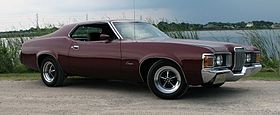 1971 Mercury Cougar | |
| Overview | |
| Model years | 1971–1973 |
| Assembly | Dearborn, Michigan, United States |
| Body and chassis | |
| Body style | Two-door hardtop Two-door convertible |
| Layout | FR layout |
| Related | Ford Mustang |
| Powertrain | |
| Engine | 351 cu in (5.8 L) Windsor V8 351 cu in (5.8 L) Cleveland V8 429 cu in (7.0 L) Super Cobra Jet V8. |
| Dimensions | |
| Wheelbase | 112.0 in (2,845 mm) |
For 1971, the Cougar was restyled, weighed less, and had only a one-inch-longer wheelbase than its predecessors (112 vs. 111 – which was similar to GM's intermediate-sized two-door models, such as the Olds Cutlass). The front end now featured four exposed headlights; the disappearing headlights were eliminated. The center grille piece was now larger, sharing its appearance with the 1971 Mercury Cyclone. The rear featured a semifastback with a "flying buttress" sail-panel. The convertible returned, as did the XR-7 and the GT package. The Eliminator package was dropped, but the Ram Air option remained. The engine lineup was revised for 1971, as well. Now only three engines were offered—the standard 240 hp (179 kW) 351 (Cleveland or Windsor) two-barrel V8, the 285 hp (213 kW) 351 Cleveland four-barrel V8, and the 370 hp (276 kW) 429 Cobra Jet four-barrel V8.
By 1972, the climate had begun to change as the muscle car era ended. No longer able to use gross power numbers, the manufacturers had to use net power figures, which dropped the once-mighty figures down substantially. Engines were shuffled around a bit with the 429 engine option no longer available. They were now the standard 163 hp (122 kW) 351 Cleveland two-barrel V8, or the 266 hp (198 kW) 351C four-barrel Cobra Jet V8. Other than that, the Cougar remained a carryover from 1971. Only minor trim details were changed in 1972. The big-block engines were gone for 1972 and 1973. The days of performance-oriented muscle cars were coming to an end.
Aside from minor grille and taillight changes, 1973 would be largely a carryover year for the Cougar, but it would mark the last year of the Mustang-based Cougar and the final run of Cougar convertibles; a light blue/white Cougar XR-7 convertible was actually the "last" convertible built by Ford Motor Company in the 1970s. An automatic transmission and power front disc brakes became standard, though a 4-speed manual transmission was still available as a rarely ordered option. Many changes were scheduled for the 1973 models. Power figures continued to change, as new federal/EPA regulations began their stranglehold on the V8 engines. The new figures continued to fluctuate, but engine options remained unchanged from 1972. The standard engine continued to be the 168 hp (125 kW) 351 Cleveland two-barrel V8. Optional was the 264 hp (197 kW) 351 Cobra Jet V8.
Additionally, an arguably little known trim style and certain mandatory options (e.g. hardtop) of Cougar was the "Bronze Age" edition made by Mercury in 1973 (also made for the models: Mercury Monterey, Mercury Montego MX, and Mercury Comet of that year).[10][11] While it was marketed primarily in copper metallic colors,[12] it was also available in 6 other colors: ivy glamour metallic, green metallic, medium brown metallic, saddle bronze, medium yellow gold and white.
Production[edit]
| Model Year | Units |
|---|---|
| 1971 | 62,864 |
| 1972 | 53,702 |
| 1973 | 60,628 |
Third generation (1974–1976)[edit]
| Third generation | |
|---|---|
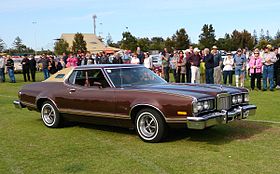 1974–1976 Mercury Cougar XR-7 2-Door Hardtop | |
| Overview | |
| Model years | 1974–1976 |
| Assembly | Atlanta, Georgia, United States |
| Body and chassis | |
| Body style | 2-door hardtop |
| Layout | FR layout |
| Related | Ford Torino Ford Elite Mercury Montego |
| Powertrain | |
| Engine | 351 cu in (5.8 L) 351M V8 400 cu in (6.6 L) V8 460 cu in (7.5 L) 385/Lima V8 |
| Dimensions | |
| Wheelbase | 114.0 in (2,896 mm) |
| Length | 215.5 in (5,474 mm)[13] |
| Width | 78.5 in (1,994 mm) |
For 1974, the Cougar was shifted from its Mustang ponycar origins and upsized onto a different platform and into a new market as a personal luxury car. It now shared a chassis with the larger Mercury Montego/Ford Torino intermediates and lent itself to create a Ford badged version released in February 1974 called Gran Torino Elite. The wheelbase grew to 114 inches (2,896 mm) and became practically the only car to be upsized during the downsizing decade of the 1970s. These years marked the end of the "luxurious Mustang", and the beginning of the Cougar's move towards becoming a "junior Thunderbird" and eventually a sibling of the Thunderbird. TV commercials compared the Cougar to the Continental Mark IV, the most notable featuring Farrah Fawcett in a 1975 TV ad.
The Cougar was marketed as an intermediate-sized personal-luxury car to compete against GM's Oldsmobile Cutlass Supreme and Buick Regal, in addition to the 1975 Chrysler Cordoba, while its corporate twin the Elite with its Thunderbird-like styling competed against the Chevrolet Monte Carlo, Pontiac Grand Prix, and the Dodge Charger. Almost every GM division had an entry in this market by 1974, and the market was too large to ignore so both Ford and Mercury expanded their offerings to compete.
The new Cougar paid homage to its smaller predecessor with a three-piece grille up front, topped by a new hood ornament which featured the Jaguar-like silhouette of a creeping Cougar. The car's Montego heritage was fairly evident from the sides and back. The Cougar acquired the sine qua non of the personal luxury car in the 1970s: opera windows. The opera windows were rectangular shaped glass mounted in the C-pillars and accompanied by a standard partial rear section vinyl roof. This body ran unchanged for three years, and during this period all Cougars were XR-7s; the base model and convertible were dropped.
Engine offerings for 1974 included a standard 351 V8 Cleveland 2V, optional but seldom ordered Q-code 351 "Cobra Jet" V8, 400 2V, and 460 4V; in 1975 the Cleveland 2V was replaced by the 351M. The automatic transmission became standard for all Cougars.
Since the Cougar was based on the Montego, it used the same interior except for some minor trim and upholstery. Interior offerings during these three years included a standard bench seat with cloth or vinyl upholstery, an optional Twin-Comfort Lounge 60/40 bench seat with center armrest and cloth, vinyl or optional leather trim; or all-vinyl bucket seats with center console. Although the car still lacked a fixed "B" pillar, the rear windows no longer rolled down, making the car more like a coupe than a true hardtop.
In 1975, the Cougar XR-7 continued to add more luxury features as it moved upmarket. But with more features, the Cougar was gaining in weight, as well. Compared to the 1967 version, the 1975 version weighed a full 1,000 lb (450 kg) more. Despite the added weight, the buying public wanted the Cougar, and sales figures reflected that fact. For the performance fans, however, a high-performance rear axle and 'Traction-Lok' differential continued to be on the option sheet. The standard engine continued to be the 148 hp (110 kW) 351M two-barrel V8 with the 158 hp (118 kW) 400 two-barrel V8 and 216 hp (161 kW) 460 four-barrel V8 optional. Visually, the only change from 1974 was the addition of two rectangular openings in the center section of the front bumper.[14]
The 1976 Cougar carried over largely unchanged from 1975. Minor trim pieces served to differentiate this year from last. Engines continued unchanged, as well. The high-performance axle and Traction-Lok differential were dropped. Twin Comfort Lounge reclining seats, with or without velour cloth trim, were the only major change for the interior.
The sheetmetal of this generation remained in use in stock car racing during the mid-1970s. A Wood Brothers Racing Mercury Cougar was the winner of the 1976 Daytona 500. Other teams, including Bud Moore Engineering, would continue to race this generation of Cougar in Winston Cup through the 1980 season.
Production[edit]
| Model Year | Units |
|---|---|
| 1974 | 91,670 |
| 1975 | 62,987 |
| 1976 | 83,765 |
Fourth generation (1977–1979)[edit]
| Fourth generation | |
|---|---|
.jpg) 1977–1979 Mercury Cougar | |
| Overview | |
| Model years | 1977–1979 |
| Assembly | Lorain, Ohio, United States Pico Rivera, California, United States |
| Body and chassis | |
| Body style | Four-door sedan Four-door station wagon Two-door coupe |
| Layout | FR layout |
| Related | Ford LTD II Ford Thunderbird |
| Powertrain | |
| Engine | 302 cu in (4.9 L) V8 351 cu in (5.8 L) V8 400 cu in (6.6 L) V8 |
| Transmission | C4 automatic FMX automatic C6 automatic |
| Dimensions | |
| Wheelbase | Coupe: 114.0 in (2,896 mm) Sedan and Wagon: 118 in (3,000 mm) |
| Length | Coupe: 215.5 in (5,473.7 mm)[15] Sedan: 219.5 in (5,580 mm) Wagon: 233.1 in (5,920 mm) |
| Width | 75.2 in (1,910.1 mm) |
| Height | 52.6 in (1,336.0 mm) |
| Chronology | |
| Predecessor | Mercury Montego (non XR-7 Cougar) |
For the 1977 model year, the fourth-generation Cougar was part of a revision of the Ford intermediate model line. The Cougar XR-7 underwent a redesign with the standard Cougar returning (for the first time since 1973) in place of the Montego. For the first time, the Cougar XR-7 was the Mercury counterpart of the Ford Thunderbird (a pairing that lasted through 1997) with Ford marketing the standard Cougar as the Ford LTD II.
The fourth generation is the best-selling version of the Cougar; with 1978 as the top-selling year for the entire model line. For 1980, Ford ended production of Torino-based vehicles, downsizing the Cougar XR-7 to a long-wheelbase version of the Fox platform.
Chassis[edit]
As with its predecessor, the fourth-generation Cougar was based from the Ford Torino "split-wheelbase" chassis. Cougar coupes and Cougar XR-7s had a 114-inch wheelbase while Cougar four-doors and station wagons had a 118-inch wheel base.
In the redesign, the powertrain offerings were revised. In the interest of fuel economy, the 460 V8 was withdrawn from intermediates, with the 173 hp 400 V8 as the highest-displacement engine. The base V8 in coupes and sedans was a 134 hp 302 Windsor V8, with a 149 hp 351 Windsor as the standard engine in station wagons; a 161 hp 351M V8 was optional in coupes and sedans. A 3-speed automatic transmission was paired to each V8 engine.
For 1978, the Cougar offered the same engines from 1977; for 1979, the 400 was discontinued.
Body design[edit]
In its replacement of the Montego, for 1977, the Cougar model line was expanded from one body style to four. Along with previous Cougar XR-7 luxury coupe, Mercury introduced a Cougar two-door coupe, a four-door sedan, and a five-door station wagon.
A central part of the 1977 redesign of the Ford intermediate range was a transition from "fuselage styling" to sharper-edged lines. As funds were concentrated on development of future models, a complete exterior redesign was precluded. On coupes, sedans, and XR-7s, all sheetmetal above the bumpers was revised. As a revision of the station wagon rear bodywork was too extensive, the Cougar/LTD II wagons adopted the redesigned 1977 front fascia on the bodywork of the previous Montego station wagon. Following the 1977 model year, the Cougar wagon was withdrawn in favor of the all new Mercury Zephyr wagon.
To bring the exterior closer in line with the larger Marquis, the Cougar adopted a nearly square radiator-style grille; in place of hidden headlamps, the Cougar adopted four square headlamps.
For 1979, though in its last year, the Cougar adopted a few body revisions, with revised taillamps and body-color grille inserts, along with an electronic voltage regulator and a plastic battery tray.
- Fourth-generation Mercury Cougar
Trim[edit]
For 1977, the Cougar was introduced in three trim levels: a base trim level and Brougham trim (for wagons, a Villager trim was offered). For 1978, the Cougar became a single trim level, with the Brougham returning as an option package.
Cougar XR-7[edit]
As with the previous generation, the Cougar personal luxury coupe continued as the Cougar XR-7. No longer a "junior Thunderbird", the XR-7 was the direct Mercury counterpart of the Thunderbird (a commonality remaining for the next 20 years). To differentiate the model from its Ford counterpart (and from standard Cougars), the XR-7 was given its own rear fascia. Evoking the flagship Continental Mark V, the rear fascia was given a (vestigial) continental tire trunklid (with angular lines) and taillights similar to the Continental Mark IV. The XR-7 roofline was distinguished from standard Cougar coupes by narrower hardtop windows and the use of louvers on the forward section of the opera windows.
The XR-7 included power disc brakes and steering, 15-inch wheels, rear stabilizer bar, walnut wood-tone instrument panel, Flight Bench seat, "XR-7" trunk key-hole door, "COUGAR" decklid script, large hood ornament (with cat emblem), and sport-styled roofline with back-half vinyl and rear opera side windows and louvers. Some XR-7s had the Rally Sport Tachometer and Gauge package (only 25% of all Cougars came with this option).
For 1978, two new decor packages became available, the XR-7 Decor Option and the Midnight/Chamois Decor Option. In line with the Designer Series from the Mark V, the latter option offered a color-coordinated exterior and interior, with a half-vinyl roof, padded "Continental" type rear deck, and Midnight Blue and Chamois interior with Tiffany carpeting.
- Fourth-generation Mercury Cougar XR-7
Production[edit]
| Model Year | Units |
|---|---|
| 1977 | 194,823 (XR-7 124,799) |
| 1978 | 213,270 (XR-7 166,508) |
| 1979 | 172,152 (XR-7 163,716) |
Fifth generation (1980–1982)[edit]
| Fifth generation | |
|---|---|
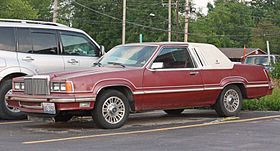 1980–82 Mercury Cougar XR-7 | |
| Overview | |
| Also called | Ford Cougar (Venezuela, sedans) |
| Model years | 1980–1982 |
| Assembly | Lorain, Ohio, United States |
| Body and chassis | |
| Body style | Two-door coupe Two-door sedan Four-door sedan Four-door station wagon |
| Layout | FR layout |
| Platform | Ford Fox platform |
| Related |
|
| Powertrain | |
| Engine | 255 cu in (4.2 L) Windsor V8 302 cu in (4.9 L) Windsor V8 140 cu in (2.3 L) Lima I4 232 cu in (3.8 L) Essex V6 200 cu in (3.3 L) Thriftpower Six I6 |
| Transmission | 5-speed Tremec T-5 manual 3-speed C5 automatic 4-speed AOD automatic |
| Dimensions | |
| Wheelbase | 105.5 in[16] 108.4 in[16] |
| Chronology | |
| Predecessor | Mercury Monarch (non-XR7 two-door, four-door) Mercury Zephyr (station wagon) |
| Successor | Mercury Marquis (non XR7) Mercury Cougar (sixth generation) (for XR7) |
For the 1980 model year, Mercury downsized the Cougar XR-7. Alongside its Thunderbird counterpart, the XR-7 entered the mid-size segment for the first time, shedding 15 inches in length, 4 inches of width, and approximately 900 pounds of curb weight (depending on powertrain). In a strategy similar to 1977, the standard Cougar returned for 1981 in place of the Monarch in the Mercury product line (sharing its body with the redesigned Ford Granada).
The first Cougar not to offer a V8 as standard equipment, the standard Cougar was produced as a two-door and four-door sedan, adopting the five-door station wagon from the Zephyr from 1982; the model line was repackaged as the Marquis for 1983 as Ford revised its full-size and mid-size product branding.
Chassis[edit]
Both the Cougar XR-7 and mid-size Cougar were produced using the Ford Fox platform.[17] The Cougar XR-7 was produced upon an extended-wheelbase Fox chassis (to 108.5 inches), shared with the 1980–1982 Ford Thunderbird, 1982–1987 LINCOLN Continental, 1984–1985 Continental Mark VII and 1986–1992 LINCOLN Mark VII. The mid-size Cougar shared its 105.5 wheelbase with the Ford Fairmont and Mercury Zephyr, the launch vehicles of the Fox platform.
Powertrain[edit]
The Cougar XR7 was offered with two V8 engines. Shared with the Mercury Marquis/Colony Park, a 4.2 L V8 was standard, with a 4.9 L V8 offered as an option; both engines were paired with a 4-speed Ford AOD overdrive automatic.
The mid-size Cougar was offered with its own powertrain lineup. Shared with the Fairmont/Zephyr and Mustang/Capri, a 2.3 L inline-4 was the standard engine, with a 3.3 L inline-6 and a 4.2 L V8 offered as options; the four and six-cylinder engines were paired with a 3-speed automatic transmission.
For 1982, an all-new 3.8 L V6 replaced the inline-6; in various forms, the engine would be used by the Cougar and Thunderbird through their 1997 discontinuation. The 4.9 L V8 option was withdrawn from the Fox platform, leaving the 4.2 L engine as the sole V8 offering for both the Cougar and Cougar XR-7.
Body[edit]
In its development, many design elements of the 1977–1979 Cougar XR-7 were carried forward in the fifth-generation redesign, including its Continental-style trunklid, louvered opera windows, and sharp-edged fender lines. While the fourth-generation Cougar XR-7 had proven highly successful in the marketplace, the design elements fell out of proportion on a radically smaller car, leading to a highly negative reception. In what would prove disastrous, the Cougar saw little to no differentiation from its Ford Thunderbird and Ford Granada counterparts, with the XR-7 externally distinguished only by its grille, exposed headlamps, taillamps, and trunklid.
During the production of the fifth-generation Cougar, the Cougar XR-7 was produced solely as a two-door coupe, with the mid-size Cougar produced as a two-door notchback coupe and four-door sedan. For 1982 only, the mid-size Cougar was offered as a station wagon replacing the Zephyr station wagon. For the first time, Cougar two-door models featured a fixed "B" pillar and a fixed steel frame around front door windows, as in the sedan.
In what would become a long-running tradition for the Mercury brand, 1981 marked the debut of GS and LS trim lines for both the mid-size and XR-7 Cougars.[18] Both trim packages were largely similar, though the LS was exclusive to four-doors. The GS package focused on appearance, while the LS package offered luxury touches such as power windows, keyless entry external number pad, and other luxury trim touches.[19] The Cougar station wagon was offered in either GS trim or woodgrained Villager trim (the Mercury equivalent of a Ford Squire station wagon).
Ford of Venezuela marketed the Fox-platform Cougar from 1983 to 1986 as the Ford Cougar Brougham four-door sedan.[20] Derived from the fifth-generation Cougar sedan, the Ford-badged Cougar Brougham was produced with the front and rear fascias of the 1983–1986 Mercury Marquis.
Production[edit]
| Model Year | Units |
|---|---|
| 1980 | 58,028 |
| 1981 | 90,928 |
| 1982 | 73,817 |
Sixth generation (1983–1988)[edit]
| Sixth generation | |
|---|---|
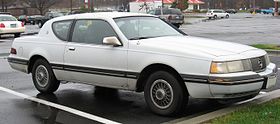 1987–1988 Cougar LS | |
| Overview | |
| Also called | Ford Cougar (Mexico) |
| Model years | 1983–1988 |
| Assembly | Lorain, Ohio, United States |
| Body and chassis | |
| Body style | 2-door coupe |
| Layout | FR layout |
| Platform | Ford Fox platform |
| Related | Ford Fairmont Ford Granada Ford LTD Ford Mustang Ford Thunderbird Mercury Capri Mercury Marquis Mercury Zephyr Continental Mark VII LINCOLN Mark VII LINCOLN Continental |
| Powertrain | |
| Engine | 2.3 L (140 cu in) Lima turbo I4 3.8 L (232 cu in) Essex V6 4.9 L (302 cu in) Windsor 5.0 V8 |
| Transmission | Five-speed Tremec T-5 manual Three-speed C5 automatic Four-speed AOD automatic |
| Dimensions | |
| Wheelbase | 104 in (2,642 mm) (1980–86) 104.2 in (2,647 mm) (1987–88) |
| Length | 197.6 in (5,019 mm) (1983–86) 200.8 in (5,100 mm) (1987–88) |
| Width | 71.1 in (1,806 mm) (1983–86) 70.1 in (1,781 mm) (1987–88) |
| Height | 53.4 in (1,356 mm) (1983–86) 53.8 in (1,367 mm) (1987–88) |
| Curb weight | 3,050–3,500 lb (1,383–1,588 kg) |
For the 1983 model year, Mercury introduced the sixth generation of the Cougar. As part of an extensive revision of the Ford and Mercury model ranges, the mid-size Mercury model range shifted from the Cougar to the Marquis (split from the full-size Grand Marquis). Reverting to its traditional role of a two-door coupe (for the first time since 1976), the Cougar remained a counterpart of the Ford Thunderbird with the two vehicles repackaged as "luxury sport coupes".[21] Within Mercury, the Cougar was slotted above the Capri and below the two-door Grand Marquis (both would be discontinued during its production).
Along with marking the first major use of aerodynamic-intensive design in an American automobile, the Cougar and Thunderbird were also the first Ford vehicles developed using computer-aided design (CAD).[21] While given a less aerodynamic roofline than the Thunderbird, the 1983 Cougar was far sleeker than the 1982 Cougar XR7, reducing its coefficient of drag from 0.50 to 0.40[22][21] In 1987, the sixth-generation Cougar underwent a mid-cycle revision with aerodynamic improvements, reducing its drag coefficient to 0.36.[23]
Chassis[edit]
The sixth-generation Cougar retained the rear-wheel drive Ford Fox platform from the fifth generation. In a departure from its predecessor, a shorter 104-inch wheelbase was used (4 inches shorter than the previous XR7).[21] As before, traditional Fox-platform underpinnings were retained, including a MacPherson strut/A-arm front suspension with a four-link coil-sprung solid rear axle with front and rear anti-roll bars.[21]
As with the previous generation, 14-inch wheels and tires were standard, with Michelin TRX tires and metric-size wheels as an option (shared with the Thunderbird and Capri/Mustang).[21] For 1985, 15-inch wheels became an option for the XR7.[24]
Powertrain[edit]
For its 1983 launch, the sixth-generation Cougar offered a 120 hp 3.8 L V6 from its predecessor as a standard engine; a 130 hp 4.9 L V8 made its return as an optional engine.[21] For 1986, the V8 was changed to sequential fuel injection, increasing output to 150 hp.[25] For 1988, the 3.8 L V6 was given multiport fuel injection, increasing output to 140 hp; the 4.9 L V8 was retuned to 155 hp.[26]
From 1984 to 1986, the XR7 was equipped with a 2.3 L turbocharged inline-4; shared with the Thunderbird Turbo Coupe, the engine produced 145 hp with an automatic transmission (155 hp with a manual transmission).[24] For 1987, the XR7 dropped the turbocharged engine (and 5-speed manual transmission) in favor of the 4.9 L V8.[23]
The 2.3L inline-four was paired with a 5-speed manual transmission; a 3-speed automatic transmission was optional. The 3.8 L V6 was paired with a 3-speed automatic; a 4-speed overdrive automatic was optional (the only transmission with the 4.9 L V8).[27] For 1987 and 1988, the 4-speed AOD transmission was fitted to both the 3.8 L and 4.9 L engines.[28]
Body[edit]
Exterior[edit]
The exterior design of the sixth-generation Cougar was designed largely in response to the negative market response to the introduction of the fifth-generation Cougar. While retaining a common chassis, a primary objective for designers was to maximize the visual differentiation between the Thunderbird and Cougar.[21] To reduce production costs, the two model lines shared exterior body parts, including front and rear bumpers, both doors, the windshield, the hood and front fenders.[21] While the Thunderbird adopted a fastback roofline, the Cougar adopted a notchback roofline with a near-vertical backlight, distinguished by upswept rear side windows.[21]
During its production, the sixth-generation Cougar underwent several exterior revisions. For 1984, the hood ornament was replaced by a flat hood emblem.[29] For 1985, the waterfall-style grille was replaced with an egg-crate design (similar to Mercedes-Benz); the red taillamp lenses were replaced by a dark gray design.[24] 1986 saw few changes, highlighted by the addition of a government-mandated center rear brake light (CHMSL) and a power-operated moonroof;[25] for the last time, the Cougar was available with vent windows.
To mark its 20th year of production, the Cougar underwent an extensive mid-cycle revision for 1987.[23] Originally slated for the 1986 model year,[24] nearly every exterior panel was changed. To visually stretch the roofline, a compound-curved rear window replaced the nearly flat rear glass and the rear quarter windows were redesigned (with a curve inversely matching the windshield angle).[23] To further distinguish the model line from the Thunderbird, the 1987 Cougar received its own grille (with a large "cat" emblem), front bumper cover and aerodynamic composite headlamps.[30] Shared with the Mustang GT, the Cougar received new 15-inch wheels, becoming the standard alloy wheel design for 1988.[23][26] For 1988, the exterior of the Cougar underwent no changes, introducing several monochromatic paint options.[26]
Interior[edit]
For its 1983 launch, to lower production costs, the sixth-generation Cougar was required to carry over interior parts from the 1980–1982 Cougar XR7, including a modified dashboard; an analog instrument panel was standard, with a digital instrument panel offered as an option.[21] For 1984, the steering column was redesigned, returning horn control to the steering wheel.[29] As part of introduction of the XR7, the model introduced an instrument panel including a tachometer and turbocharger boost gauge.[29] For 1985, the interior underwent a complete redesign, with new door panels and dashboard; a redesigned rear seat expanded seating capacity to five passengers (four passengers with full-length console).[24] The standard instrument panel was a digital speedometer with analog secondary gauges; a fully digital instrument panel was optional (the XR7 was given a fully analog instrument panel).[24]
For the 1987 model year, the Cougar saw few changes to its interior, with the XR7 adopting a fully digital dashboard as standard equipment.[23] For 1988, the analog XR7 dashboard made its return; along with the deletion of the boost gauge, the tachometer was revised for a lower-revving V8 engine.[26]
Trim[edit]
The sixth-generation Cougar continued the trim nomenclature of its predecessor in modified form, with the Cougar GS serving as the base trim, the Cougar LS as the luxury trim, and the Cougar XR7 as the high-performance version. The GS trim was largely used for internal purposes, with advertising dropping the designation entirely.[21] For 1987, to move the Cougar upmarket, the Cougar LS became the standard trim level, with both V6 and V8 engines available.
For 1984, the XR7 made its return after a year-long hiatus. Serving as the counterpart of the Thunderbird Turbo Coupe, the XR7 was fitted with a performance-oriented suspension, a turbocharged 2.3 L engine (shared with the Turbo Coupe and Mustang SVO), blacked-out window trim, and full analog instrumentation. In 1987, to better distinguish the Cougar XR7 from the Thunderbird Turbo Coupe, the turbocharged inline-4 was replaced by a 4.9 L (302 cu in) V8, along with a standard 4-speed automatic.
20th Anniversary[edit]
For the 1987 model year, Mercury produced the Mercury 20th Anniversary Cougar as a commemorative edition.[31] Derived from the Cougar LS, the 20th Anniversary Cougar was produced in a near-monochromatic exterior (Cabernet Red with Midnight Smoke moldings); the wheels, all badging, and regular chrome trim were finished in 24 karat gold, with a gold-trimmed C-pillar emblem.[31] The trunk was fitted with a (non-functional) luggage rack.[31]
The 20th Anniversary Cougar was fitted with the 4.9 L V8, sport-handling suspension with quad rear shocks (derived from the XR7) and 15-inch alloy wheels (from the Mustang GT, painted gold).[31] Along with a limited-slip rear axle, the only options offered were a power moonroof, power antenna, illuminated entry, keyless entry, automatic climate control, and an engine block heater.
In total, Mercury produced 5,002 20th Anniversary Cougars; 800 were reserved for Canada.[31]
Production[edit]
| Model Year | Units |
|---|---|
| 1983 | 75,743 |
| 1984 | 131,190 |
| 1985 | 117,274 |
| 1986 | 135,904 |
| 1987 | 105,847 |
| 1988 | 113,801 |
Seventh generation (1989–1997)[edit]
| Seventh generation | |
|---|---|
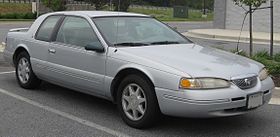 1997 Mercury Cougar XR7 Sport | |
| Overview | |
| Also called | Ford Cougar (Mexico) |
| Model years | 1989–1997 |
| Assembly | Lorain, Ohio, United States |
| Body and chassis | |
| Body style | 2-door coupe |
| Layout | FR layout |
| Platform | Ford MN12 platform |
| Related | Ford Thunderbird LINCOLN Mark VIII |
| Powertrain | |
| Engine | 3.8 L Essex V6 (1989–1997) 5.0 L Windsor V8 (1991–93) 4.6 L Modular V8 (1994–97) |
| Transmission | Four-speed AOD (1989–1993) or 4R70W automatic Five-speed manual M5R2(1989–90) |
| Dimensions | |
| Wheelbase | 113.0 in (2,870 mm) |
| Length | 1989–1991: 198.7 in (5,047 mm) 1992–94: 199.9 in (5,077 mm) 1995–97: 200.3 in (5,088 mm) |
| Width | 1989–1994: 72.7 in (1,847 mm) 1995–97: 73.1 in (1,857 mm) |
| Height | 1989–1991: 52.7 in (1,339 mm) 1992–97: 52.5 in (1,334 mm) |
| Curb weight | 3528 lb (1600 kg) with V6 3666 lb (1663 kg) with V8 |
On 26 December 1988, the seventh-generation Mercury Cougar was introduced for the 1989 model year.[32] Developed from the second quarter of 1984, as a counterpart of the tenth-generation Ford Thunderbird, the $2 billion redesign of the two vehicles was intended to create handling benchmarked against far more expensive coupes (BMW 6-Series, Mercedes-Benz 560SEC, Jaguar XJS) while remaining in the same price segment.[32][33] During the development of the 1989 Cougar, the form factor of coupes shifted significantly, as the quartet of GM G-body coupes were replaced by front-wheel drive vehicles; the introduction of the Acura Legend by Honda marked the introduction of Japanese-produced luxury vehicles.
At its 1989 debut, the Cougar was marketed largely as the flagship coupe of the Mercury division. As Mercury revised its model line during the 1990s, the Cougar became the sole two-door model offered by the division. As market demand shifted away from large two-door coupes, the Mercury Cougar and Ford Thunderbird were discontinued after the 1997 model year, with the final example produced on 4 September 1997.
Chassis[edit]
The seventh-generation Mercury Cougar is built upon the Ford MN12 platform.[32] Designed specifically for the Mercury Cougar and Ford Thunderbird, the MN12 chassis retained the use of rear-wheel drive. While its exterior footprint changed negligibly, in a major change, the wheelbase was expanded nine inches to 113 inches (longer than a Mercedes-Benz 560SEC).
Centered around the design of the MN12 chassis was its use of four-wheel independent suspension in place of a live rear axle.[32] With the exception of the Chevrolet Corvette, the Ford MN12 chassis marked its first use in a mass-produced American automobile. In front, the Mercury Cougar was configured with a short/long arm wishbone suspension.[32] As an option, the Cougar was available with 4-wheel antilock disc brakes (standard on the Cougar XR7).[32]
As part of the 1989 redesign, the MN12 chassis was powered solely by a 3.8 L V6, as the lowered hoodline of the MN12 was too low to properly house the 5.0 L V8, the engine was removed from the model line (marking the first time no V8 was available for the Cougar or Thunderbird).[32] LS-trim Cougars were offered with a naturally aspirated 140 hp version of the V6, while the XR7 was powered by a 210 hp supercharged version (serving as the replacement for the turbocharged 2.3 L inline-4). The naturally aspirated V6 was paired with a 4-speed automatic transmission, while the supercharged V6 was offered with a 5-speed manual (with the automatic as an option).
For 1991, to increase demand for the Cougar, Mercury introduced a 200 hp version of the 5.0 L V8, a redesigned intake manifold allowed for sufficient underhood clearance.[34] Offered as an option on the Cougar LS, the V8 replaced the supercharged V6 in the XR7 (which also marked the end of the 5-speed manual in the MN12 Cougar). Originally slated for 1993, the 1994 Cougar shifted from the overhead-valve 5.0 L V8 to a 205 hp 4.6 L SOHC V8 (shared with the Mercury Grand Marquis).[35] In another 1994 change, the 4R70W electronically controlled version of the AOD 4-speed automatic was introduced for both the V6 and V8 engines.
Body[edit]
As the sixth-generation Mercury Cougar had proved successful in the marketplace, the 1989 redesign of the Cougar was largely an evolution of the previous generation, with updates of many previous design elements. The upright notchback roofline underwent a major revision, with the controversial upswept quarter windows of the previous generation abandoned.[32] While proportioned differently, wraparound headlamps and taillamps were modeled similar to the Mercury Sable. As a result of the longer wheelbase, the rear overhang was shortened. During development of MN12, Ford designers sought to develop increased differentiation between the Cougar and Thunderbird. While fenders and doors are common between the two vehicles, in comparison to the 1983–1987 generation, fewer visible parts are shared.[32]
As part of the shift to the wider MN12 chassis, the Cougar again became a 5-passenger vehicle (for the first time since 1982). As a result of the wider interior, all Cougars were fitted with a center console with a floor-mounted shifter.[32] In following with the previous generation, LS-trim Cougars were fitted with digital instrumentation; the Cougar XR7 was fitted with an analog instrument panel.[32] Originally slated to be launched with dual airbags, cost overruns and market demand necessitated the use of automatic seatbelts to meet passive-restraint requirements.[32] For 1994, the interior underwent a complete redesign (similar to the LINCOLN Mark VIII), with dual airbags replacing the automatic seatbelts.[35] For 1997, the Cougar received a new instrument panel (similar to the Taurus/Sable), with cupholders added to the center console;[36] several items were removed as part of de-contenting, including the courtesy lamps, underhood light and glove box light.
During its production, the seventh-generation Mercury Cougar underwent several revisions. For 1991, the Cougar underwent a slight facelift, with new headlamps and taillamps and front bumper; the facelift is distinguished by a smaller grille (1989–1990 versions extend above the headlamps).[34] For 1994, a second facelift saw a revision of the grille, taillamps and a simplification of the side molding. The interior was also revised at this time and now included dual airbags with a wraparound style interior.[35] For 1996, the Cougar received a major restyling sharing its entire front fascia with the Ford Thunderbird except for the front bumper cover and grille. The bodysides received wide body-colored cladding.[37]
Trim[edit]
At its launch, the seventh-generation Mercury Cougar retained the same model trims as before, with the LS geared towards luxury and convenience features and the XR7 geared towards performance and handling. Externally, the LS was given chrome window trim while the XR7 was nearly monochromatic with black window trim.[32] To optimize its handling capabilities, the XR7 was fitted with many model-specific features. In addition to the 210 hp supercharged V6 (replaced by a 5.0L V8 in 1991), the XR7 featured four-wheel antilock disc brakes, electronically adjustable handling suspension, 16-inch alloy wheels, and a 5-speed manual transmission.[32][38][39] To differentiate the XR7 from the LS, the model was fitted with sport seats, two-spoke sport steering wheel, and full analog instrumentation.[38][39]
For 1993, Mercury revised the Cougar model line, with the XR7 becoming the sole trim level, dropping the LS and the monochromatic sport-oriented XR7 (eliminating some overlap with the Ford Thunderbird). Adapting much of the equipment of the previous LS, the 1993 XR7 adapted chrome exterior trim and a standard digital instrument cluster, with four-wheel disc brakes becoming an option.[40] In contrast to the previous LS, the 1993 XR7 offered both V6 and V8 engines.[40]
Alongside the LS and both versions of the XR7, several limited editions of the Cougar were produced. To commemorate the 25th anniversary of the Mercury Cougar, in 1992, the 25th Anniversary Mercury Cougar was an option package (nearly exclusively on XR7 models).[41] Equipped with 15" BBS alloy wheels, all examples were painted green with a tan interior (with green carpet). Other features included model-specific trunklid and C-pillar badging and an imitation trunklid luggage rack.[41] To commemorate the 30th anniversary of the Mercury Cougar, for 1997, Mercury produced a 30th Anniversary Mercury Cougar XR7 as an option package.[42] Distinguished by its use of LINCOLN Mark VIII wheels, the 30th Anniversary Cougar featured model-specific C-pillar emblems, embroidered seat and floormat emblems; the option also included commemorative items shipped to the owner.[42] Approximately 5,000 25th anniversary and 5,000 30th anniversary Cougars were produced.[41][42]
Production[edit]
| Model Year | Units |
|---|---|
| 1989 | 97,246 |
| 1990 | 76,467 |
| 1991 | 60,564 |
| 1992 | 46,928 |
| 1993 | 79,700 |
| 1994 | 71,026 |
| 1995 | 60,201 |
| 1996 | 38,929 |
| 1997 | 35,267 |
Eighth generation (1999–2002)[edit]
| Eighth generation | |
|---|---|
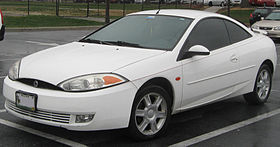 2001–2002 Mercury Cougar | |
| Overview | |
| Also called | Ford Cougar (Export) |
| Production | 1998 – 9 August 2002 |
| Model years | 1999–2002 |
| Assembly | Flat Rock, Michigan, United States |
| Body and chassis | |
| Class | Sport compact |
| Body style | 3-door liftback coupe |
| Layout | Transverse front-engine, front-wheel drive |
| Platform | Ford CDW27 platform |
| Related | |
| Powertrain | |
| Engine | |
| Transmission | |
| Dimensions | |
| Wheelbase | 106.4 in (2,700 mm) |
| Length | 185.0 in (4,700 mm) |
| Width | 69.6 in (1,770 mm) |
| Height | 52.2 in (1,330 mm) |
| Curb weight | 2,892 lb (1,312 kg) |
By the mid-1990s, Ford engineers had completed design work on the third generation of the Ford Probe. Intended for a 1998 model year launch, the new Probe shifted its design from the Mazda MX-6 to a platform shared with the Ford Contour. At the end of the 1997 model year, Ford announced a major streamlining of its coupe offerings, with Ford discontinuing the Thunderbird and Probe; LINCOLN-Mercury lost the Cougar and LINCOLN Mark VIII (the latter, after 1998). To make room for the updated 1999 Ford Mustang and all-new Ford Escort ZX2, the Contour-based Ford Probe continued into production, with Ford shifting the vehicle to the LINCOLN-Mercury Division to adopt the Mercury Cougar name.
After skipping the 1998 model year, Mercury introduced the eighth-generation Mercury Cougar for the 1999 model year at the 1998 Los Angeles Auto Show. Serving as the replacement for the Ford Probe, the first front-wheel drive Cougar shifted market segments from two-door personal luxury coupe to three-door sport compact, introducing the first Mercury sport hatchback coupe since the 1986 Mercury Capri.
While marketed in Europe and Australia under the Ford brand, the eighth-generation Mercury Cougar was the first Mercury car since the 1991–1994 Mercury Capri sold without a direct Ford model equivalent in North America.
Initially outranking its predecessor in sales, the eighth-generation Cougar (marketed towards younger buyers, similar to the ZX2) struggled to compete for sales against sedans (the Mercury Sable and Grand Marquis) in the Mercury model line. While coupes had traditionally been offered in LINCOLN-Mercury dealerships for several decades, the shift of the Cougar to the sports compact segment presented a challenge to sales personnel acquainted to marketing luxury-segment vehicles to new-car buyers along with attracting younger buyers into Mercury showrooms.
In 2002, Ford announced another restructuring of its model line, with 2002 marking the final year for the Cougar, Mercury Villager, LINCOLN Continental, and Ford Escort. The Ford Contour/Mercury Mystique (Ford Mondeo MkII) ended production in 2000, with the Cougar outliving it by two model years. As part of the model line revision, the Ford Mondeo platform was no longer used in North America until its consolidation with the 2013 Ford Fusion; the Mercury Cougar was effectively left without a donor platform.
The last Mercury Cougar rolled off the assembly line on 9 August 2002; following the end of its production, the Mercury model line offered no cars with four-cylinder engines until the 2006 Mercury Milan.
Chassis[edit]
The 1999 Cougar shared the Ford CDW27 world-car platform introduced by the Ford Contour/Mercury Mystique. The first front-wheel drive Cougar, it was designed with fully independent multilink suspension.
The 1999–2002 Cougars were available with two engine options, the 2.0-L Zetec straight-4 engine with 125 hp (93 kW; 127 PS), and the 2.5-L Duratec V6 with 170 hp (127 kW; 172 PS). Also, two transaxle options were available: the manual Ford MTX-75 transmission or the automatic Ford CD4E transmission (available in the US with either engine, although the I4/automatic combination was extremely rare; supposedly only 500 Cougars were built with the I4/auto).
"Sport Package" models of the V6 featured four-wheel vented disc brakes (from the Contour SVT), 16-inch alloy wheels, and the speed governor removed. With the electronic speed limiter removed, the top speed of the car was limited by drag and engine power in top gear at redline, around 135 mph (217 km/h).[citation needed] While this was considered attainable given enough road, the automatic transmission version could not reach this speed without significant engine modification. However the manual transmission version of the car, when given enough road, was capable of reaching speeds of around 145. Without the sport package, the speed governor was set at 115 mph (185 km/h) due to the H-rated tires with which the car was equipped.
Ford also prepared two high-performance concept-only versions; one dubbed the "Eliminator", which was a supercharged version built with aftermarket available parts, and the other the "Cougar S", which featured new body work, all-wheel drive and a 3.0-L Duratec engine.
A high-performance Cougar S (not to be confused with the concept) was discussed in the press, which was essentially a Cougar with a Contour SVT engine; however, this version never made it into production. The Cougar S was so close to production, though, many of its parts are still available to order from the dealership and it is listed in many parts catalogs and insurance databases.[citation needed] It was also to be sold in Europe as the Ford Cougar ST200.
Body[edit]
This generation of Cougar had a far more contemporary package, with modern DOHC 24-valve six-cylinder Duratec engines, a fully independent multilink suspension, and front-wheel drive. This was also the first hatchback Cougar, and the first to have its own body, unshared by any Ford (except its European twin Ford Cougar). The body design used a philosophy Ford dubbed "New Edge" design: a combination of organic upper body lines with sharp, concave creases in the lower areas. The Cougar's body, and the New Edge idea in general, was introduced as a concept called the Mercury MC2 in 1997, and was considered a bigger version of the European Ford Puma.
Ford also sold this generation of Cougar in Europe and Australia as the Ford Cougar, and it was a sales success.
To help create excitement for the Cougar, Mercury created several paint and trim packages:
- Special Edition (2000 model year) available in Zinc Yellow, leather interior with yellow stitching on the seats
- C2 (2001–2002 model years) available in either French Blue, Silver Frost, or Vibrant White, along with special blue interior accents
- Zn (2001 model year) available with special Zinc Yellow, special Visteon hood scoop and spoiler
- XR (2002 model year) available in either Black or XR Racing Red, with special black and red seats and interior trim, also came with 17-inch silver wheels with black accents on the inner spokes
- 35th Anniversary (2002 model year) versions were available in Laser Red, French Blue, Satin Silver, and Black; most came with leather interiors with silver center sections on the seats. They also came with 17-inch machined wheels, the same as the XRs without the black paint on the center spokes.
- Roush Edition (1999–2000 model year) Available mostly in white and silver color choices, this car was built under the Roush name with body work done to the front bumper, back, side skirts and more. It is considered the rarest of all Cougars, since only 112 were ever made during its two-year production.
For the 2001 model year, the Cougar was updated with new headlights, front and rear fascias, and updated interior trim.
US production numbers[edit]
| Model Year | Units[43] |
|---|---|
| 1999 | 88,288 |
| 2000 | 44,935 |
| 2001 | 25,044 |
| 2002 | 18,321 |
Ford Cougar (Export)[edit]
In 1998, Ford launched the Cougar at the 1998 British Grand Prix at Silverstone.[44] Without the Mercury brand in Europe and Australia, Ford marketed the Cougar as the Ford Cougar through Ford of Europe and Ford of Australia from 1999 to 2002. Replacing the Ford Probe in European markets, the Ford Cougar was manufactured in the United States. Slotted above the Ford Ka and Ford Puma (both based on the Ford Fiesta subcompact), the Cougar was marketed as a mid-sized coupe.
With the exception of Ford Blue Oval badging replacing Cougar emblems on the exterior and interior, Ford and Mercury versions are essentially identical. Export Cougars also have clear marker light lenses (in place of amber) and amber rear turn signals. In the United States, the Ford Cougar was built in both left and right-hand drive, with the latter allowing for its sale in the UK and Australia.
Racing[edit]
In 1967, renowned NASCAR race car builder Bud Moore campaigned Mercury Cougars in the Trans-Am Series with Ford Motor Company factory support. The team featured superstar-caliber drivers, such as Captain Dan Gurney, Parnelli Jones, Peter Revson, David Pearson, and Ed Leslie. Factory support dried up towards the end of the season and the Cougars began to show their wear. Ultimately, Mercury lost the championship to Ford by two points.[45]
In 1968, Bud Moore took his Cougars NASCAR racing in the newly formed Grand American series. Star driver Tiny Lund dominated the series and took the championship. After the Cougar changed to the Thunderbird platform in 1974, the bodystyle was raced in NASCAR. The Wood Brothers Racing team with David Pearson and later Neil Bonnett was very successful with the car and scored a number of victories until the bodystyle became ineligible following the 1980 season. The next year (1981) saw the previous Cougar teams switch to the Thunderbird when NASCAR mandated the smaller (110-inch-wheelbased) cars, though oddly the Thunderbirds had to have their wheel bases stretched 6 inches, as the production cars wheelbase was only 104 inches.
From 1989 to 1990, LINCOLN-Mercury Motorsport fielded Cougars of the new body style in the GTO class of the IMSA GT Championship. The cars collected the championship both years, and continued the teams' streak to seven manufacturer's championships.
References[edit]
- ^ Jewett, Larry. "The Sign of the Cat". Gretoville.com. Retrieved 9 April 2012.
- ^ "1967 Mercury brochure". Archived from the original on 13 January 2017. Retrieved 12 January 2017.
- ^ Severson, Aaron (18 March 2013). "Hand-Me-Down Cat". Autoweek. 63 (6): 20–21.
- ^ "Ford Motor Company – Featured Story – Fords Past, Present and Future Come to Carlisle". Media.ford.com. Archived from the original on 6 June 2007. Retrieved 9 April 2012.
- ^ "History of Ford Swing-Away, Tilt-Away, and Tilt Steering Wheels". Automotive Mileposts. Retrieved 13 March 2017.
- ^ Guide to Muscle Cars Magazine, 6/87, p.79.
- ^ CCOA, cougarclub.org. "Cougar Club of America production statistics courtesy of Marti Auto Works". Cougarclub.org. Archived from the original on 11 October 2008. Retrieved 9 April 2012.
- ^ Gunnell, John (2006). standard catalog of American Muscle Cars 1960–1972. Krause Publications. ISBN 0-89689-433-9.
- ^ http://oldcarbrochures.org/index.php/New-Brochures---Oct/1969-Mercury-Cougar-Brochgure-Rev/1969-Mercury-Cougar-Rev--05
- ^ "Other Special Cougars". Cougar Club of America. 2000. Retrieved 1 January 2016.
- ^ "Cougar A Source Book, edited and annotated by Thomas E Bonsall, 1967 Thru 1976" page 118.
- ^ McLellan, Robert. "Auto Literature, Car Sales Brochures & Catalogs: McLellans Automotive". www.mclellansautomotive.com.[permanent dead link]
- ^ "Archived copy". Archived from the original on 13 January 2017. Retrieved 12 January 2017.CS1 maint: archived copy as title (link)
- ^ John Gunnell, Standard Catalog of American Cars 1946–1975, Revised 4th Edition, page 546
- ^ http://oldcarbrochures.org/index.php/New-Brochures---Aug/1997-Mercury-Cougar-Brochure-Cdn/1977-Mercury-Cougar-Cdn--16
- ^ Jump up to: a b Cougars for 1981 from LINCOLN-Mercury, page 16, oldcarbrochures.org Archived 2 April 2015 at the Wayback Machine Retrieved on 19 March 2015
- ^ Dave Epperson, Popular Hot Rodding's All About 1981 Cars, page 49
- ^ "1981 Mercury Cougar brochure". www.oldcarbrochures.com. Retrieved 12 September 2019.
- ^ "1981 Mercury Cougar brochure". www.oldcarbrochures.com. Retrieved 12 September 2019.
- ^ "1983 Ford Cougar Brougham (Venezuela)". Retrieved 9 September 2018.
- ^ Jump up to: a b c d e f g h i j k l "Cool Cats, Celebrating The 1983–88 Mercury Cougar". www.coolcats.net. Retrieved 11 January 2019.
- ^ "ShieldSquare Captcha". validate.perfdrive.com. Retrieved 11 January 2019.
- ^ Jump up to: a b c d e f "Cool Cats, Celebrating The 1983–88 Mercury Cougar". www.coolcats.net. Retrieved 11 January 2019.
- ^ Jump up to: a b c d e f "Cool Cats, Celebrating The 1983–88 Mercury Cougar". www.coolcats.net. Retrieved 11 January 2019.
- ^ Jump up to: a b "Cool Cats, Celebrating The 1983–88 Mercury Cougar". www.coolcats.net. Retrieved 12 January 2019.
- ^ Jump up to: a b c d "Cool Cats, Celebrating The 1983–88 Mercury Cougar". www.coolcats.net. Retrieved 12 January 2019.
- ^ "Cool Cats, Celebrating The 1983–88 Mercury Cougar". www.coolcats.net. Retrieved 11 January 2019.
- ^ "Cool Cats, Celebrating The 1983–88 Mercury Cougar". www.coolcats.net. Retrieved 11 January 2019.
- ^ Jump up to: a b c "Cool Cats, Celebrating The 1983–88 Mercury Cougar". www.coolcats.net. Retrieved 11 January 2019.
- ^ "1987 Mercury Couga brochure". oldcarbrochures.com. p. 4. Retrieved 23 January 2020.
- ^ Jump up to: a b c d e "Cool Cats, Celebrating The 1983–88 Mercury Cougar". www.coolcats.net. Retrieved 14 January 2019.
- ^ Jump up to: a b c d e f g h i j k l m n "AERO CATS, Celebrating The 1989–97 Mercury Cougar". www.aerocats.net. Retrieved 8 May 2018.
- ^ Holloway, Charles A.; Bowen, Professor H. Kent; Clark, Kim B.; Wheelwright, Steven C. (1994). The Perpetual Enterprise Machine: Seven Keys to Corporate Renewal Through Successful Product and Process Development. ISBN 9780195080520.
- ^ Jump up to: a b "AERO CATS, Celebrating The 1989–97 Mercury Cougar". www.aerocats.net. Retrieved 8 May 2018.
- ^ Jump up to: a b c "AERO CATS, Celebrating The 1989–97 Mercury Cougar". www.aerocats.net. Retrieved 8 May 2018.
- ^ "AERO CATS, Celebrating The 1989–97 Mercury Cougar". www.aerocats.net. Retrieved 8 May 2018.
- ^ "AERO CATS, Celebrating The 1989–97 Mercury Cougar". www.aerocats.net. Retrieved 8 May 2018.
- ^ Jump up to: a b "Archived copy". Archived from the original on 18 August 2017. Retrieved 18 August 2017.CS1 maint: archived copy as title (link)
- ^ Jump up to: a b "Archived copy". Archived from the original on 18 August 2017. Retrieved 18 August 2017.CS1 maint: archived copy as title (link)
- ^ Jump up to: a b "AERO CATS, Celebrating The 1989–97 Mercury Cougar". www.aerocats.net. Retrieved 8 May 2018.
- ^ Jump up to: a b c "AERO CATS, Celebrating The 1989–97 Mercury Cougar". www.aerocats.net. Retrieved 8 May 2018.
- ^ Jump up to: a b c "AERO CATS, Celebrating The 1989–97 Mercury Cougar". www.aerocats.net. Retrieved 8 May 2018.
- ^ "99-02 Mercury Cougar production numbers". NewCougar.org. 18 October 2004. Retrieved 4 September 2011.
- ^ "About the Ford Cougar". The Ford Cougar Owners Club.
- ^ 1967 Trans-Am Scores at www.trans-amseries.com Retrieved on 5 September 2010
External links[edit]
| Wikimedia Commons has media related to Mercury Cougar. |
| show |
|---|
| show « previous — Mercury passenger vehicle timeline, 1980–2011
|
|---|
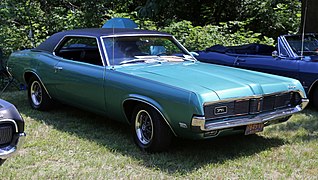
.jpg)
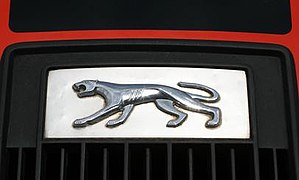
.jpg)
.jpg)


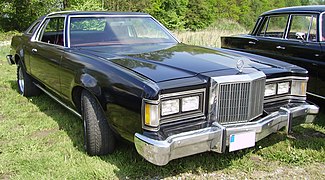


.jpg)
.jpg)
.jpg)
.jpg)
.jpg)
.jpg)
.jpg)
.jpg)
.jpg)
.jpg)
.jpg)



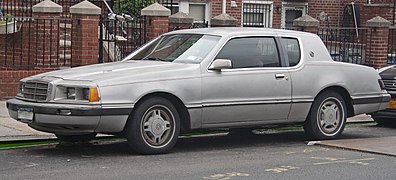
,_Echo_Park.jpg)




.jpg)
